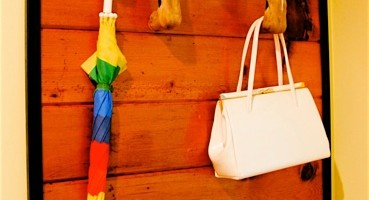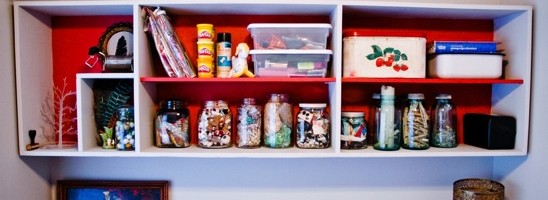Check it out!
While Biceps and I were on a romantic date at Habitat for Humanity, I scored a swag light down rod and a trash can cover for $1. He always takes me to the coolest places. I knew I could make something from them, and he couldn’t argue with the price.

You may already know that I have an affinity for log-inspired pieces around my home. (Check out my Mod Log Table). While passing by one of my rent houses, I saw a felled tree and grabbed a chunk of it from an old pal’s front yard. With my two Habitat pieces in hand and now my chunk o’ log, history was about to be made.
Or at least a ‘Lovely Leftovers Lamp’.

Here’s what you’ll need to make your own ‘Lovely Leftover Lamp’.
A drill with a paddle bit (I used a 1”)
Router or a Skill Saw
Belt or Palm Sander with 40 & 80 grit paper
Polyurethane and Foamy Brush
Tape Measure
Chunk o’ Log with the cross-cuts parallel to each other (mine is 3 1/2” tall and 7” in diameter)

You’ll also need:
Trash Can Cover (mine was 8 1/2” in diameter-you could use fancy tin cans, or learn how to make your own Cutey Cans)
Swag Down Rod
Additional Wiring, wire nuts & Switch (if the old wiring is sketchy looking)
Spray Paint that matches your trash can cover
3” Threaded Rods
3/16” Threaded Aluminum Posts

I sprayed my 3” Threaded Rods and 3/16” Threaded Aluminum Posts GOLD to match the rest of my lamp.
These little buggers will attach the trash can cover to the down rod.

I sanded my log to be baby smooth, starting with a 40 grit and then moving up to an 80 grit.

After your log is smooth on both sides, measure the diameter of your log and mark the center.
Easy enough.

I used a 1” paddle bit to drill through the center of my log which accommodated the 1” diamater of my down rod. Adjust the size of your bit to the size of your down rod.
If your down rod is bigger than 1”, you may need to use a hole saw (which also attaches to your drill).
Drill all the way through, allowing your drill to rest periodically when the bit gets too hot. A hot drill bit and a lot of sawdust tends to have a weird reaction that I like to call ‘Fire’.

Next, we’ll make a channel on the bottom of our log for the wiring to come through.
It would be best to use a router, but since I didn’t have one, I went with a skill saw that I depth set to 1”. You aren’t cutting through the whole log, just making a channel for your wiring.

I know this channel for my wiring isn’t that pretty, but since it’s the undercarriage of my log (weird) and I will be covering it with some sort of soft feltiness in the long run, I was alright with it. Now that all of the sanding and cutting is done, wipe off your log thoroughly with a microfiber cloth.

Break out the poly and your foamy brush. Apply a thin layer of poly to your log. Let dry according to your manufacturer’s directions. Once the log is dry, use a steel wool to lightly sand the top and bottom, removing any air bubbles.
Re-apply a second coat if you desire. I usually desire.

I needed a longer run of wire, and decided to tie in some white wire that I had leftover from another project, using two wire nuts that didn’t match and one of which was covered in a sticky substance.
Don’t judge. I’m going for cheap here.

Line up the tips of your exposed copper wire which should be about a 1/4” long, and place the wire nut on top of the two wires (Connect the ribbed wire-it will feel like it has ribs on it, to the other ribbed wire. Connect your smooth wire to your smooth wire).
Screw down the wire nut as far as possible and pull the wires away from the wire nut, making sure they are firmly attached. I used electrical tape around the nuts and wires, just as an added precaution.

Place your down rod through the hole you drilled in your log, feeding the wire through the channel on the bottom of your log. You can cover the bottom of your log with felt or fabric using a hot glue gun.
I know you guys like your glue guns. Get crazy.

I wanted a switch on my lamp, and since they are super easy and cheap, I went for it. I like cheap and easy.
Follow the instructions on the package. It took me less than a minute to do this.

Flip your log over. Attach your trash can cover to your down rod by using your spray painted threaded posts and rods. Feed the 3” threaded rods from the outside in, threading it into the top of the down rod where a globe is usually attached. Use your threaded posts to cap the end of the threaded rods on the outside of your trash can cover. If you have a solid cover, you may need to drill out tiny holes for your threaded rods to go through.
Let’s plug it in!

Isn’t it just so purty? I love my new ‘Lovely Leftovers Lamp’!























































